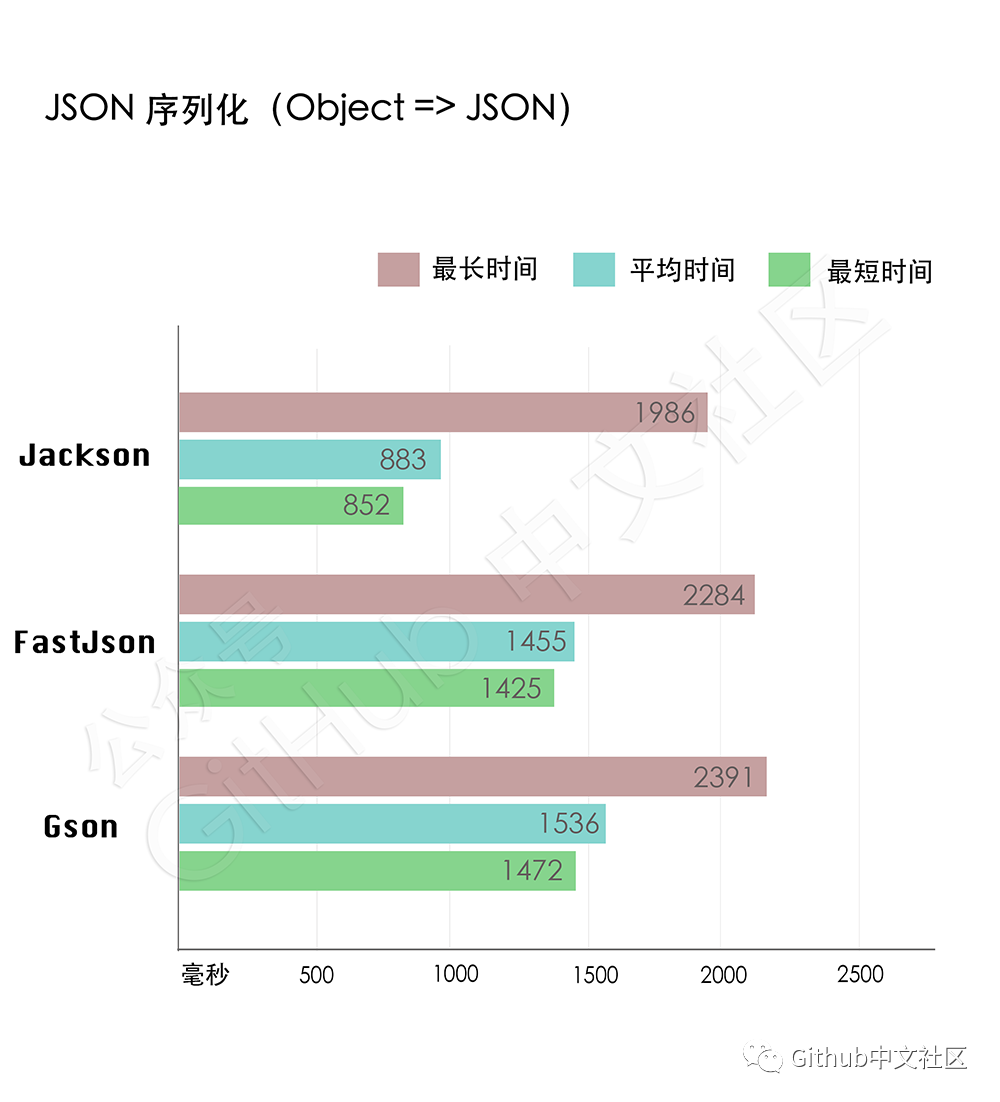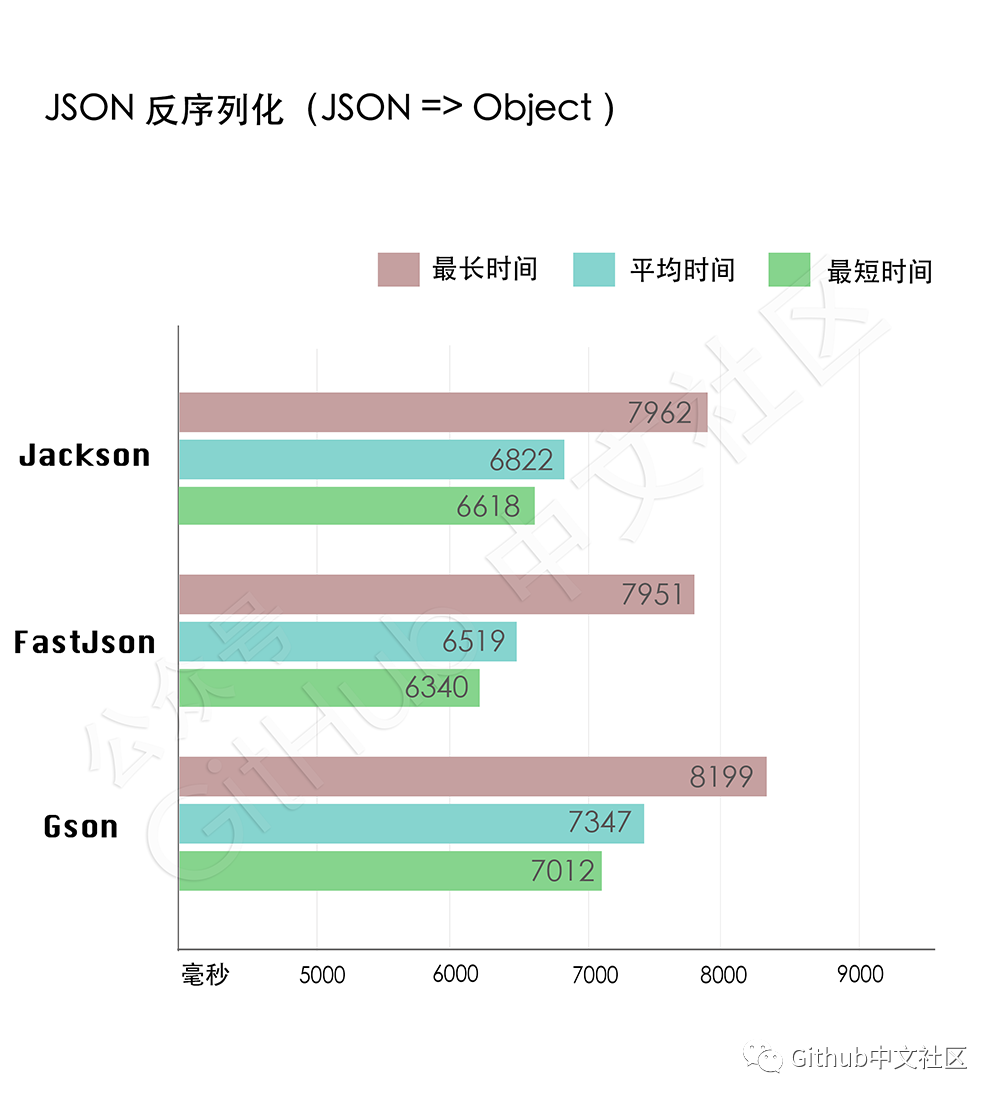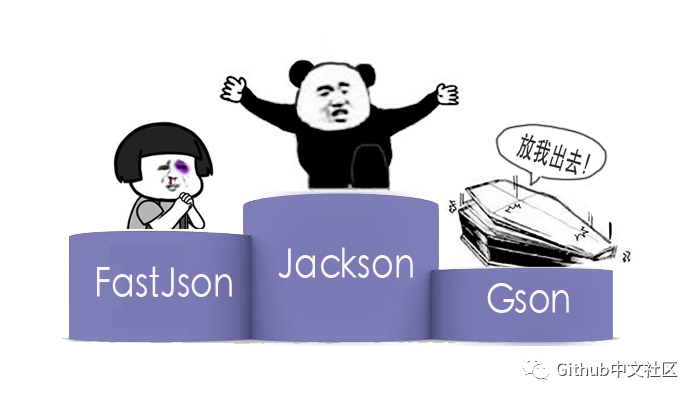三款主流的 JSON 解析库性能大比拼
点击“ 开发者技术前线 ”,选择“星标:top:”
在看|星标|留言, 真爱

第005期原创分享
大家好,我是hub哥,又到了本期分享。这期我们来聊聊Java中解析JSON的三个主流类库 :
FastJSON 、 Gson 和 Jackson 。
先来看下这三货在Github上的基本数据:
FastJson
Github地址:https://github.com/alibaba/fastjson

Jackson
Github地址 :https://github.com/FasterXML/jackson

Gson
Github地址 :https://github.com/google/gson

码友们对这三货各方面也一直争议不断,大多关心的,还是性能以及稳定性。本文主测性能;对于这三个库的简介以及用法,就不去废话了,一个简单明了的测评,直接上!
主要对这三个类库在JSON序列化和反序列化在速度方面的表现做一些测评,为了防止由于内存导致测试结果出现偏差,测试中对JVM内存配置-Xmx4g -Xms4g。
测试代码已经贴到了文章末尾。

JSON序列化(Object => JSON)
测试样本数量为100000个,为了保证每个类库在测试中都能处理同一个样本,先把样本Java对象保存在文件中。每个类库测试5次,每次循环测试10遍,去掉最快速度和最慢速度,对剩下的8遍求平均值作为最终的速度,取5次测试中最好的平均速度作为最终的测试数据。
测试结果:

从测试数据可以看出,Jackson是最快的(耗时比Gson少了大约700毫秒), Gson耗时最久 。

JSON反序列化(JSON => Object)
同样,测试样本数量为100000个,为了保证每个类库在测试中都能处理同一个样本,先把样本JSON对象保存在文件中。每个类库测试5次,每次循环测试10遍,去掉最快速度和最慢速度,对剩下的8遍求平均值作为最终的速,取5次测试中最好的平均速度作为最终的测试数据。
测试结果:

从测试数据可以看出, 在反序列化上性能 FastJson 最快,不过与Jackson差距并不明显 ,Gson耗时最久

可见,不管是序列化还是反序列化,速度方面首先阵亡的,是Gson!

那还剩下FastJson和Jackson
FastJson 在某些方面确实快一些,但是和 Jackson 的差距不大,优势并没有太明显。Jackson还可以加上AfterBurner来使用byte generation,这样和 FastJson 的差距就更小了。
除了在反序列化的速度胜出外, FastJson 相比较 Jackson 有不少短板,我们可以从以下3方面对比:
1. 可定制性
Jackson有灵活的API,可以很容易进行扩展和定制,而且很多时候需要的模块都已经有人提供了。比如guava中定义的数据类型,比如kotlin语言Immutable的类型等,比如java8 引入的新日期时间类型和Optional都已经有支持的模块。
FastJson只有一个(简陋)的SerializeFilter机制用来定制序列化,ParseProcess机制用来定制反序列化,每次调用序列化/反序列化的的时候都要自己传filter或者Process这个参数过去,Jackson和 Gson都是直接注册模块就可以了,Jackson还可以使用SPI来自动发现和注册模块。
2. 代码质量
公司有一些项目使用了Fastjson,在使用 Fastjson
的项目里面曾碰到过的两个低级bug:
1. 碰到在128~255 的字符直接异常,这些主要是西欧语言的字符,因为他用一个数组来记录 转义后的字符表示,但是数组长度只有128...
2. 内存占用过多。Fastjson为了性能,在ThreadLocal中缓存了char[] buffer,这样避免分配内存和gc的开销。但是如果碰到了大的json(比如10M这样的),就会占用大量的内存,而且以后都是处理小JSON了内存占用也回不来。
这些问题虽然后来的版本都修复了,但是也反映出Fastjson代码质量上要求不够严格。而Jackson这么多年来使用上还没有碰到过这样的Bug.
3. 文档
相比Jackson, Fastjson
英文文档就显得比较欠缺,已有的也不规范,这样就更没法指望老外用了,相对还是国内开发者占大多数
这么来看,最终结果很明显了:

观点
JSON从发明到现在之所以流行,并不是因为json快的原因(比json快且小巧的格式和类库一大把),而是因为json和web结合的时候更易于使用,对开发人员易于理解。很多人拿FastJson和Jackson比,就像拿非智能机和iphone比待机时间,其功能性不一样,Jackson的很多功能FastJson并没有实现,所以这种对比也不客观。FastJson之所以没在国际上流行起来,最主要的原因应该是开发者的思路全放到“快”上去了,而偏离了“标准”及功能性,质量也不够好,有点“舍本逐末”的味道。
当然在目前的环境下,国产软件能踏实的心态做好开源的不多,FastJson团队能这么快的反馈并修正问题,这种精神还是值得称赞的。希望国内的技术从业者能更重视“技术的原始需求”。
测试代码:
样本对象包括Boolean、Int、Long、Double、Date、String、List和Map字段,其中List长度和Map的Key数量可以根据需要改变。
/**
* 样本数据工厂 提供各类元数据样本
*/
public class DataFactory {
private static final String[] chars = new String[] { "0", "1", "2", "3", "4", "5", "6", "7", "8", "9", "a", "b",
"c", "d", "e", "f", "g", "h", "i", "j", "k", "l", "m", "n", "o", "p", "q", "r", "s", "t", "u", "v", "w",
"x", "y", "z", "A", "B", "C", "D", "E", "F", "G", "H", "I", "J", "K", "L", "M", "N", "O", "P", "Q", "R",
"S", "T", "U", "V", "W", "X", "Y", "Z" };
// 配置各项长度/数量
private static final int charNum = 62;
private static final int maxStrLength = 120;
private static final int defaultStrLength = 50;
private static final int maxListSize = 120;
private static final int defaultListSize = 20;
private static final int maxMapSize = 120;
private static final int defaultMapSize = 20;
private static final String[] types = new String[] { "string", "int", "long", "double", "boolean", "date"};
private static final int typeNum = 6;
private static final Random random = new Random();
/**
* 生成随机长度的字符串
* @return 字符串
*/
public static String randomString(){
return randomString(random.nextInt(maxStrLength));
}
/**
* 生成指定长度字符串
* @param len 字符串长度
*/
public static String randomString(int len) {
if (len < 1 || len > maxStrLength) {
len = defaultStrLength;
}
StringBuilder sb = new StringBuilder(len);
for (int i = 0; i < len; i++) {
sb.append(chars[random.nextInt(charNum)]);
}
return sb.toString();
}
/**
* 生成List,元素的数量随机
* @return
*/
public static List<String> randomStringList() {
return randomStringList(random.nextInt(maxListSize));
}
/**
* 生成List样本
* @param size 元素的数量
* @return
*/
public static List<String> randomStringList(int size) {
if (size < 1 || size > maxListSize) {
size = defaultListSize;
}
List<String> list = new ArrayList<String>();
for (int i = 0; i < size; i++) {
list.add(randomString(random.nextInt(maxStrLength)));
}
return list;
}
/**
* 生成随机Map样本,key的数量随机
* @return
*/
public static Map<String, Object> randomMap() {
return randomMap(random.nextInt(maxMapSize));
}
/**
* 生成随机Map样本
* @param size key的数量
* @return
*/
public static Map<String, Object> randomMap(int size) {
if (size < 1 || size > maxMapSize) {
size = defaultMapSize;
}
Map<String, Object> map = new HashMap<String, Object>();
for (int i = 0; i < size; i++) {
String type = types[random.nextInt(typeNum)];
if ("boolean".equals(type)) {
map.put("key" + i, random.nextBoolean());
} else if ("int".equals(type)) {
map.put("key" + i, random.nextInt());
} else if ("long".equals(type)) {
map.put("key" + i, random.nextLong());
} else if ("double".equals(type)) {
map.put("key" + i, random.nextDouble());
} else if ("date".equals(type)) {
map.put("key" + i, new Date());
} else if ("string".equals(type)) {
map.put("key" + i, randomString(random.nextInt(maxStrLength)));
}
}
return map;
}
}
/**
* 样本对象
*/
public class TestEntity implements Serializable {
private Double dataDouble;
private Date dataDate;
private String dataStr;
private Boolean dataBoolean;
private Integer dataInt;
private Long dataLong;
private List<String> dataList;
private Map<String, Object> dataMap;
public TestEntity() {
Random random = new Random();
dataBoolean = random.nextBoolean();
dataInt = random.nextInt();
dataLong = random.nextLong();
dataDouble = random.nextDouble();
dataDate = new Date();
dataStr = DataFactory.randomString();
dataList = DataFactory.randomStringList(defaultListSize);
dataMap = DataFactory.randomMap(mapKeyNum);
}
/**
* 指定元素数量的样本
*/
public TestEntity(int listSize, int mapKeyNum) {
Random random = new Random();
dataBoolean = random.nextBoolean();
dataInt = random.nextInt();
dataLong = random.nextLong();
dataDouble = random.nextDouble();
dataDate = new Date();
dataStr = DataFactory.randomString();
dataList = DataFactory.randomStringList(listSize);
dataMap = DataFactory.randomMap(defaultMapSize);
}
// get and set
// ......
}
/**
* 测试入口
*/
public class TestBuilder {
public static void main(String[] args) {
int testSize = 100000;
String jsonDataPath = "d://test_json.dat";
String objectDataPath = "d://test_object.dat";
buildJson(testSize, 10, 10, jsonDataPath);
buildObject(testSize, 10, 10, objectDataPath);
}
public static List<String> loadJSON(String filePath) {
List<String> list = new LinkedList<String>();
File file = new File(filePath);
if (!file.exists()) {
return list;
}
BufferedReader br = null;
try {
br = new BufferedReader(new FileReader(file));
String line = br.readLine();
while(line != null){
list.add(line);
line = br.readLine();
}
} catch (Exception e) {
e.printStackTrace();
} finally {
if (null != br) {
try {
br.close();
} catch (IOException e) {
}
}
}
return list;
}
@SuppressWarnings("unchecked")
public static List<TestEntity> loadTests(String filePath) {
List<TestEntity> list = new LinkedList<TestEntity>();
File file = new File(filePath);
if (!file.exists()) {
return list;
}
ObjectInputStream ois = null;
try {
ois = new ObjectInputStream(new FileInputStream(file));
list = (List<TestEntity>) ois.readObject();
} catch (Exception e) {
e.printStackTrace();
} finally {
if (null != ois) {
try {
ois.close();
} catch (IOException e) {
}
}
}
return list;
}
/**
* 创建样本
*
* @param testSize 样本数量
* @param listSize 样本List长度
* @param mapKeyNum 样本Map的Key数量
* @return 样本List
*/
public static List<TestEntity> buildTest(int testSize, int listSize, int mapKeyNum) {
List<TestEntity> list = new LinkedList<TestEntity>();
for (int i = 0; i < testSize; i++) {
list.add(new TestEntity(listSize, mapKeyNum));
}
return list;
}
/**
* 创建默认样本
*/
public static List<TestEntity> buildTest(int testSize) {
List<TestEntity> list = new LinkedList<TestEntity>();
for (int i = 0; i < testSize; i++) {
list.add(new TestEntity());
}
return list;
}
/**
* 创建样本,并把样本JSON序列化,保存到文件中。
*
* @param testSize 样本数量
* @param listSize 样本List长度
* @param mapKeyNum 样本Map中Key的数量
* @param filePath 样本输出的文件路径
*/
public static void buildJson(int testSize, int listSize, int mapKeyNum, String filePath) {
File file = new File(filePath);
File parent = file.getParentFile();
if (!parent.exists()) {
parent.mkdirs();
}
if (file.exists()) {
file.delete();
}
List<TestEntity> list = buildTest(testSize, listSize, mapKeyNum);
StringBuilder sb = new StringBuilder();
for (TestEntity item : list) {
sb.append(JSON.toJSONString(item));
sb.append("/n");
}
BufferedWriter bw = null;
try {
file.createNewFile();
bw = new BufferedWriter(new FileWriter(file));
bw.write(sb.toString());
bw.flush();
} catch (IOException e) {
e.printStackTrace();
} finally {
if (null != bw) {
try {
bw.close();
} catch (IOException e) {
}
}
}
}
public static void buildJson(int testSize, String filePath) {
File file = new File(filePath);
File parent = file.getParentFile();
if (!parent.exists()) {
parent.mkdirs();
}
if (file.exists()) {
file.delete();
}
List<TestEntity> list = buildTest(testSize);
StringBuilder sb = new StringBuilder();
for (TestEntity item : list) {
sb.append(JSON.toJSONString(item));
sb.append("/n");
}
BufferedWriter bw = null;
try {
file.createNewFile();
bw = new BufferedWriter(new FileWriter(file));
bw.write(sb.toString());
bw.flush();
} catch (IOException e) {
e.printStackTrace();
} finally {
if (null != bw) {
try {
bw.close();
} catch (IOException e) {
}TestEntity
}
}
}
public static void buildObject(int testSize, String filePath) {
List<TestEntity> list = buildTest(testSize);
File file = new File(filePath);
File parent = file.getParentFile();
if (!parent.exists()) {
parent.mkdirs();
}
if (file.exists()) {
file.delete();
}
ObjectOutputStream oos = null;
try {
file.createNewFile();
oos = new ObjectOutputStream(new FileOutputStream(file));
oos.writeObject(list);
} catch (IOException e) {
e.printStackTrace();
} finally {
if (null != oos) {
try {
oos.close();
} catch (IOException e) {
}
}
}
}
/**
* 生成样本对象,并保存到指定文件
*
* @param testSize 样本大小
* @param listSize 样本中List字段长度
* @param mapKeyNum 样本中Map对象Key数量
* @param filePath 样本输出的路径
*/
public static void buildObject(int testSize, int listSize, int mapKeyNum, String filePath) {
List<TestEntity> list = buildTest(testSize, listSize, mapKeyNum);
File file = new File(filePath);
File parent = file.getParentFile();
if (!parent.exists()) {
parent.mkdirs();
}
if (file.exists()) {
file.delete();
}
ObjectOutputStream oos = null;
try {
file.createNewFile();
oos = new ObjectOutputStream(new FileOutputStream(file));
oos.writeObject(list);
} catch (IOException e) {
e.printStackTrace();
} finally {
if (null != oos) {
try {
oos.close();
} catch (IOException e) {
}
}
}
}
}

开发者技术前线 ,汇集技术前线快讯和关注行业趋势,大厂干货,是开发者经历和成长的优秀指南 。
好文点个在看吧!
- 本文标签: ip UI 时间 json final 文章 ArrayList 质量 配置 需求 DOM 开发 ACE LinkedList tab map 代码 parse 参数 http HashMap rand 测试 cat GitHub 解析 快的 entity bug stream 定制 Google HTML 软件 src id zab web js API App list lib 希望 缓存 java https 数据 智能 key build mmap JVM git 开发者 CTO XML 开源 IO equals
- 版权声明: 本文为互联网转载文章,出处已在文章中说明(部分除外)。如果侵权,请联系本站长删除,谢谢。
- 本文海报: 生成海报一 生成海报二











![[HBLOG]公众号](http://www.liuhaihua.cn/img/qrcode_gzh.jpg)

